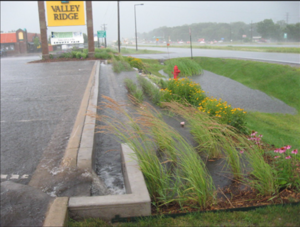
Difference between revisions of "Assessing the performance of swales"
m |
m |
||
| Line 20: | Line 20: | ||
*[https://stormwaterbook.safl.umn.edu/analysis-water-and-soils Analysis of Water and Soils] | *[https://stormwaterbook.safl.umn.edu/analysis-water-and-soils Analysis of Water and Soils] | ||
*[https://stormwaterbook.safl.umn.edu/data-analysis Data Analysis for Monitoring] | *[https://stormwaterbook.safl.umn.edu/data-analysis Data Analysis for Monitoring] | ||
| − | |||
<noinclude> | <noinclude> | ||
==Related pages== | ==Related pages== | ||
Revision as of 18:12, 13 May 2022
Swales retain solids and associated pollutants by settling and filtering. A typical method for assessing the performance of of BMPs with underdrains is therefore measuring and comparing pollutant concentrations at the influent and effluent. If the swale is designed for infiltration, see Assessing the performance of bioretention.
An online manual for assessing BMP treatment performance was developed in 2010 by Andrew Erickson, Peter Weiss, and John Gulliver from the University of Minnesota and St. Anthony Falls Hydraulic Laboratory. The manual advises on a four-level process to assess the performance of a Best Management Practice.
- Level 1: Visual Inspection. This includes assessments for infiltration practices and for filtration practices. The website includes links to a downloadable checklist.
- Level 2: Capacity Testing. Level 2 testing can be applied to both infiltration and filtration practices.
- Level 3: Synthetic Runoff Testing for infiltration and filtration practices. Synthetic runoff test results can be used to develop an accurate characterization of pollutant retention or removal, but can be limited by the need for an available water volume and discharge.
- Level 4: Monitoring for infiltration or filtration practices
Level 1 activities do not produce numerical performance data that could be used to obtain a stormwater management credit (stormwater credit). BMP owners and operators who are interested in using data obtained from Levels 2 and 3 should consult with the MPCA or other regulatory agency to determine if the results are appropriate for credit calculations. Level 4, monitoring, is the method most frequently used for assessment of the performance of a BMP.
Use these links to obtain detailed information on the following topics related to BMP performance monitoring:
- Developing an Assessment Program
- Water Budget Measurement
- Sampling Methods
- Analysis of Water and Soils
- Data Analysis for Monitoring
Related pages
- Overview for filtration
- Types of filtration
- Design criteria for filtration
- Construction specifications for filtration
- Assessing the performance of swales
- Assessing the performance of sand filters
- Operation and maintenance of filtration
- Calculating credits for sand filter
- Calculating credits for swale
- Cost-benefit considerations for filtration
- References for filtration
Links to pages discussing assessment of other BMPs can be found at this page.

